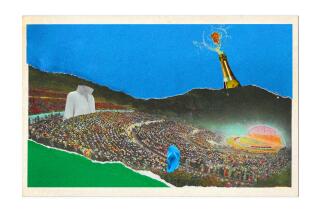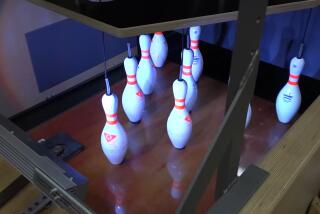Listening to Pins Drop Is Out of This World
- Share via
You know what one of the most relaxing sounds in the world is? The woody thunk of tumbling bowling pins echoing though an old bowling alley.
My girlfriend and I repaired to Costa Mesa’s venerable Kona Lanes Sunday night, after I’d spent that and the previous two days selling at a show of rare guitars in Pomona. It’s exhausting work, this business of jacking musical instrument prices up so high that actual musicians can’t afford them anymore, and I’d only had a couple of hours sleep the whole weekend.
Perhaps as revenge, the prevailing attitude of many of the musicians trying out electric guitars at this show seemed to be, “Sure, you’ve heard this cliched blues riff before, but not this loud .” There’s something about three days of overlapping Clapton licks that can really set your teeth to gnashing.
Maybe it was because, consciousness-wise, I was approaching a Malt-o-Meal-like state of being, but at the Kona Lanes I felt utterly content just to sit and listen to the pins drop. It was like hearing the surf rolling in. It was Zen, though also it was Bud.
Costa Mesa at large is scarcely Action Central after 10 p.m., but here it was nearing midnight on Sunday and every single lane was occupied. Not that we would have attempted bowling anyway, because the place seemed to have been taken over by the Enlightened Masters League or something: The bowlers appeared to be ordinary Joes, in various degrees of extra-large, but they were bowling nothing but strikes, one after another after another.
The balls moved with a simple grace, many sliding right to the lip of the gutter and then curving back to take out all 10 pins with a ratifying clatter. You could watch the same thing happening in lane after lane, like it was some mass rite.
According to the trusty Encyclopaedia Britannica, in old Germany bowling was a religious rite, in which a strike could absolve one from sin. If that had caught on, maybe we’d be watching “Bowling for Forgiveness” now on Sunday morning TV.
Though the encyclopedia maintains that the sport didn’t catch on in England until the 16th Century, I once was in an ancient pub in a little Devonshire village where they claimed to have been drinking and bowling since before Christ. They certainly looked it.
Given that this place wasn’t too many drunken stumbles away from Stonehenge and some creepy ancient earthworks, it set me to thinking that maybe there’s something to this bowling and religion business. Consider that bowling is an act of man standing in a proscribed place beyond which he cannot go--the black line--reaching out with an extension of his will--the ball--to influence or interact with an essence--the pins--he cannot otherwise aspire to. It’s the very definition of the mystical experience.
Only nine pins were used in bowling until the 18th Century, when many U.S. states banned the sport due to the gambling it attracted. As the laws specifically forbade a nine-pin game, adding the 10th pin got around them. But bowling for the ancients was a nine-pin game. There are nine planets in our solar system, but the ancients didn’t know about Uranus, Neptune and Pluto. They included the Earth, moon and sun in their reckonings and still came up with nine orbs in the sky. So by bowling, mankind may have been trying symbolically to reach the stellar embodiments of its gods.
While any Druids worth their robes should have been able to sense that there are nine planets, they may have wanted to build a massive representation of the five planets visible to the naked eye, particularly if they were lazy sods and the pub was about to open. At Stonehenge the central ring is its famed, cosmically aligned array of five trilithons, while the oldest of Stonehenge’s rocks, the Heel Stone, was placed a ways from it at the end of a long “lane” bordered by “gutters.” All they need to do now is find a 17-foot-tall ball with three holes and another of the world’s great mysteries will have been solved, courtesy of OC Live!
There’s something of the eternal to be found even in your neighborhood lanes. The yak-like brown carpet on the partitions sure qualifies. There are some concessions to the times, such as “rock-n-bowl” nights and a nod to our litigious mood via signs that declare “All players assume responsibility for own safety while bowling!” But, otherwise, these places have changed far less than the world outside them. There’s little of the high-tech fever that has made other sports into expensive jokes.
The most newfangled thing at the Kona Lanes appears to be the ball-polishing machine. For 50 cents, it promises to give your ball a gloss finish; for $1 a high-gloss one; or for $1.50 a “super gloss” sheen. Any more money than that and it probably pleasures your ball into an ecstatic state from which it never returns.
Since we weren’t playing but still felt some impulse to connect --and probably would still be sitting there if we hadn’t gotten up and done something --we took one of the battered house balls from the rack, put it in the ball polisher and listened to the machine hum for two minutes as the ball spun against a rosin wheel. It may be one of life’s simpler pleasures, but when we returned the ball to its companions, gleaming like a cherry drop next to their dull Milk Dud surfaces, we knew how the good Samaritan felt.
What a grand meatloaf of a sport! I can acknowledge this even though my personal bowling experiences haven’t exactly connected with the infinite.
My first time in a bowling alley, on my ninth birthday, I got beat up by a group of what we called “hard guys” in the ‘60s. A couple of years later, a schoolmate had a birthday party. He was already barely tolerated because his parents made him play the accordion. Then, for this party, his folks took us all bowling, which at the time didn’t quite rate on the “cool” scale next to slot-car races and minibikes. I think we beat him up.
My next time bowling was in the former Soviet Union, oddly enough. The Sovs had installed a couple of Bally lanes in the basement of this hulking concrete tourist hotel in Leningrad, with the idea of keeping the tourists from roaming when they weren’t on officially blinkered tours.
The bowling itself was fine, but first one was subjected to the whim of the gray attendant, who made bowling a Soviet sport by applying a massive half-hour bureaucratic apparatus--I think it required our passports--to our getting three pair of ill-fitting shoes before we could use the otherwise abandoned lanes.
I don’t think the Soviets ever quite got the feel for bowling, proving once again that communism is godless.
T. Jefferson Parker’s column resumes in this spot next week.
More to Read
Go beyond the scoreboard
Get the latest on L.A.'s teams in the daily Sports Report newsletter.
You may occasionally receive promotional content from the Los Angeles Times.










